The Business Continuity Imperative: Analytics and Data for Engaging Digital Experiences in 2020 and Beyond
Analytics and data provide visibility into an organization’s past, present and potential performance. However, not all organizations are using analytics that provide timely insights — insights that not just reflect what happen but direct a successful course for the future. Demand for personalized and relevant insight only intensifies in a black-swan event. To maintain business continuity in times of pressure, it is critical that organizations not waste any time or resources when using analytics and data to optimize operations and decision-making. Just having an analytics and data-first mentality and operating in the cloud is insufficient for success, as those are just part of an effective data and analytics effort. Organizations also should include data science and machine learning that can provide an excellent digital experience; unfortunately, this is no simple task.
It is not unreasonable to focus on satisfying the workforce’s appetite for analytics and data, but leaders too often neglect the digital experience and stick to the status quo of visualizations within dashboards or tools designed for data scientists. By 2023, three-quarters of organizations will need to transition beyond existing visualization-oriented analytics to those that provide personalized insights that can be read or heard. Organizations often use the term insights too loosely; true insights consist of information presented in the form of stories that are easy to interpret and act upon.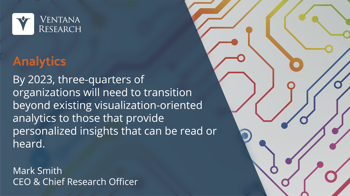
The ubiquitous goal of transforming the workforce into citizen data scientists is more fantasy than reality, wishful thinking on the part of those who have no understanding of the priorities and pressures of roles and responsibilities across the business. Organizations should pursue a more human approach delivered through an excellent digital experience. Organizational agility and readiness demand innovation and new methods that make data and analytics available to anyone in the organization, regardless of data competencies, talent and skills. This requires an investment of time and resources.
Operating under duress during a crisis such as a global pandemic and achieving business continuity is a challenge for any organization’s skillset, particularly if digital transformation investments did not make it to business areas that needed it most. In fact, Ventana Research asserts that through 2021, one-half of organizations will realize that digital transformation investments have not met the organizational readiness requirements of business continuity, leading to a new focus on innovative digital technologies that more reliably sustain operations. Analytics and data need to be part of that mission.
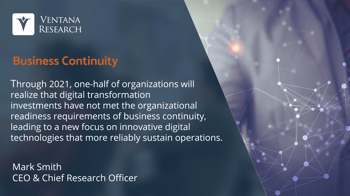 The business continuity imperative requires that organizations make it a priority to examine areas that are often overlooked but that make a meaningful impact on the business and objectives. First on the list should be ensuring that everyone in the workforce — leadership, managers and employees — has a digital experience with data and analytics that’s simple and sophisticated. Organizations should seek to enable effective work engagement by providing information that’s consistent and readily available no matter the channel, whether business applications, collaboration and productivity tools or platforms that facilitate work anywhere at any time of the day.
The business continuity imperative requires that organizations make it a priority to examine areas that are often overlooked but that make a meaningful impact on the business and objectives. First on the list should be ensuring that everyone in the workforce — leadership, managers and employees — has a digital experience with data and analytics that’s simple and sophisticated. Organizations should seek to enable effective work engagement by providing information that’s consistent and readily available no matter the channel, whether business applications, collaboration and productivity tools or platforms that facilitate work anywhere at any time of the day.
It’s critical that organizations provide a digital experience that exceeds expectations, and this requires providing information that is accurate, relevant and easy to act upon and make decisions. The sustainability of every organization hinges on analytics and data technology investments that enable an impactful and interactive workforce. This, as I have previously discussed, is essential to business continuity and an organization’s overall performance.
Building Continuity through Analytics and Data
Every organization should start by assessing all short- and long-term efforts related to the digital experience around analytics and data that are critical for business continuity. Furthermore, organizations that haven’t yet unified analytics and data and moved it to the cloud must make this an immediate priority. It’s more difficult to readily access analytics and data when it’s not managed in a unified manner that ensures an acceptable level of resiliency for business continuity. Agility is near impossible if the current approach involves a tangle of spreadsheets and custom applications, but it’s essential to go beyond conventional wisdom. Moving to the cloud is a basic step in digital transformation, but that doesn’t mean that everything will be just fine. We have all witnessed the peril of this mindset. Many current approaches lack agility and require significant process and technology improvements to support excellent digital experiences.
Organizations should cultivate technology that enables experiences with analytics and data that generate insights and encourage a more interactive and engaged workforce — whether in the physical world or through applications that provide the place for actions and decisions. Doing this requires more intelligent, streamlined and automated analytics and data processes so responsible parties can focus on areas that need immediate improvement, including the velocity and volume of information to optimize business processes. This level of processing requires artificial intelligence (AI) and machine learning (ML) that can operate in real time to support the engagement through natural language processing (NLP) that can be used for searching and presenting in the manner desired through chat or voice methods. This is why my colleague Dave Menninger asserts that by 2022, more than half of analytics processes will be enhanced by artificial intelligence and machine learning to streamline operations and increase the value that can be derived from data.
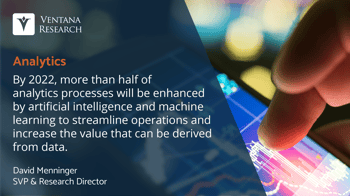 Success requires more than dashboards; it’s about more than increasing levels of productivity and even sustaining those efforts in best and worst of times and under pressure and over time. Business success is about increasing effectiveness and bringing new value to the workforce itself to gain maximum outcomes.
Success requires more than dashboards; it’s about more than increasing levels of productivity and even sustaining those efforts in best and worst of times and under pressure and over time. Business success is about increasing effectiveness and bringing new value to the workforce itself to gain maximum outcomes.
A clear understanding of analytics and data requires a technology platform that works across public and private cloud computing environments — and potentially integrates with virtualized and directly with on-premises systems. To streamline efforts organizations should aim to unify and consolidate an often-broad array of data and analytics tools. Decades of analytics tools and data infrastructure acquisitions have created significant silos and, as a result, disparities and multiple definitions of critical metrics as well as customer and product information. This siloed data infrastructure has been more evident in recent years, especially with data lakes, data marts and data warehouses that operate in public and private cloud environments. Many of these environments do not work in a distributed and interconnected manner and lack the integration and data virtualization needed for analytics. To overcome these challenges, organizations should start anew and focus on the broader value of analytics and data alongside workers, managers and leaders’ requirements. They should look to simplify architectures so they can managed them efficiently and rely on performance and scalability with defined multi-year real and total cost of ownership.
Analytics and data should do more than just enhance the productivity of operations. They should provide insights on critical metrics that indicate the health of the business. Furthermore, a portfolio of critical analytics is incomplete without good data governance using data catalogs that inventory these digital assets across all systems that support the need for continuous data and analytics. Organizations also mustn’t neglect basic principles of information management, as data preparation and data integration technologies are essential to ensuring a streamlined process across a multitude of applications and systems in the cloud and on premises. In addition, data architectures should support real-time, event- and message-based architectures that can support analytics needs at the pace at which business operates. Without strong, consistent and clearly communicated policies on digital security for the information of the organization, and especially from analytics and data, the efforts to simplify analytics might just stream those insights to the competition or criminals. Organizations must address these risks with investments in cybersecurity technology.
The digital experience of analytics and data can help unify an organization’s efforts to not just sustain continuity but bring new value to the business that exceeds workforce expectations. Optimizing the effectiveness of analytics is more than just a nicety; it’s essential for every organization that looks to make the most of engaging the workforce with actionable insights. An organization’s investment in its analytics and data will determine its success and this is impossible without high-quality, seamless digital experiences. In fact, Ventana Research asserts that by 2022, one-half of organizations will determine that the digital experiences they provide are not intelligent or automated and fall short in maintaining business continuity for organizational readiness, resulting in lost customers and workforce instability. Organizations must leverage analytics and data to ensure longevity in the operations and effectiveness of the workforce.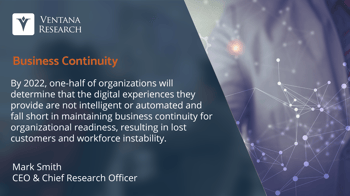
To maintain business continuity during challenging times, an organization may need to offer flexibility to its customers, partners, suppliers and its workforce. Doing this effectively requires analytics and data to ensure decisions minimize risk and maximize outcomes. This is especially difficult when the digital experience lacks guidance that’s personalized and relevant. Without it, an organization won’t be able to elevate the impact of these essential digital technology investments; I recently discussed why this is a critical part of your mission for business continuity and beyond.
Digital Communications is Essential
Managing digital experiences requires not just the right insights from analytics and data but ones that are provided through unified communications and collaboration tools that support the experiences in the organization, especially those of your customers. Challenges such as a global pandemic or a natural disaster demand digital communication across a distributed and potentially virtualized workforce; however, crises often shift priorities and engagement can suffer. Being collaborative and responsive in communications is important and organizations must design digital experiences around analytics and data that the entire organization can embrace. This is what organizational readiness and agility — and business continuity — is all about.
And this is why we assert that through 2023, one-third of organizations will initiate business continuity planning to realign the priority of technology investments required to operate seamlessly in a distributed and virtual manner in customer, product, supply chain and workforce processes. Organizations must ensure that their digital communication technologies enable collaboration, interoperate with analytics and data tools and provide digital experiences that help engage the workforce and every aspect of work across business processes.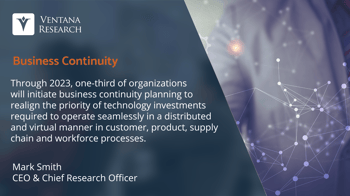
Organizations must enable digital collaboration among all parties in the workforce involved in using analytics and data to reduce friction and enable efficient actions and decision-making. This collaboration might be best achieved through conversational computing methods such as intelligent virtual agents (IVA), which are smarter than most pre-programmed bots and can respond intelligently to the needs of the workforce with technologies such as NLP blended with AI and ML. These technologies make it simpler to get insights generated from an organization’s analytics and data investments.
Engaging an organization in new, virtual ways is essential to enacting work management methods that best support processes anywhere in the organization. It’s important that an organization rally its digital communications efforts during a crisis such as a pandemic, because effectiveness in business processes requires collaboration across the organization. To be effective and achieve business continuity, organizations should establish best practices and technology that guides improvement to digital experiences, enhancing virtual interactions across the workforce and to the buyers, customers, partners and suppliers. And organizations must keep this axiom of business continuity in mind: Analytics and data must support all types of digitally secure and open communications outside of normal operations, including the necessary contextual collaboration within workforce technology.
Digital Experiences Matter
Many organizations use analytics as they have over the last three decades — create some metrics on data, place into a chart and put into a dashboard — but few of these applications support a dedicated focus on automating and optimizing the analytics and data lifecycle to generate actionable insights for business. A quality digital experience requires the right technology, which currently we don’t find in the traditional ERP or CRM applications, or even in analytics or historical BI approaches that focus on historical dashboards and visualization. We assert that through 2022, one-third of organizations will decide their analytics need to be replaced because they distract rather than guide actions and decisions to meet goals and objectives.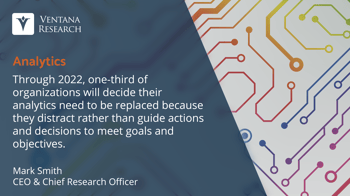
It’s important that an organization make investments into analytics and data that support automated and intelligent digital experiences that include insights that guide priorities and decisions and improve outcomes. Technology vendors historically have focused on presentation and visualization rather than easy consumption and use but this is beginning to change. A modern approach to analytics should be focused on a superior user experience that enables easy collaboration and organizational agility.
Organizations must improve by assessing and prioritizing improvements to analytics and data processes to optimize engagement across the entire organization and not just among the data scientists who can interpret them. Using the right technology is foundational to success and creates opportunities for breakthrough potential that far exceeds the visualization tools. Digital experiences that deliver sustainable impact are only possible when an organization is deliberate about the technology it uses to work collaboratively. It’s easier to achieve organizational agility and thus the impact of work with a unified approach to digital communication platforms that are open and secure.
True workforce engagement demands organizations consider the human dynamic: Reading and conversation often is far easier to understand and act on than a visualization or series of charts on a screen. In addition, it’s possible to deliver analytics on mobile devices so that the user experience feels similar to reading the news, whether in a car or on the couch. Efforts such as this not only enhance the digital experience but increase potential for an individual to have a positive impact. We assert through 2020, two-third of organizations will realize that siloes across the enterprise of on-premises deployments for business applications and technology such as analytics need to be replaced to operate in a cloud and mobile environment and meet business continuity needs.
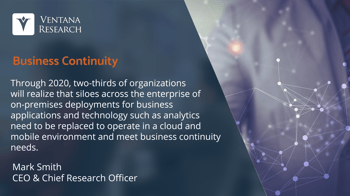 Organizations should seek to establish a Voice of Analytics (VoA) program with a set of processes and technology that uses workforce feedback and sentiment to gain insights that will optimize the needs and impact of data and analytics. By 2022, only one-quarter of organizations will have a VoA program effective enough to improve digital experiences using analytics. Organizations can better determine sentiment about their approach to analytics by collecting feedback from the workforce at time of use or when individuals want to voice their needs. If an organization is unable to capture and monitor interactions and online feedback from all relevant parties, then it’s probably missing the insights required to effectively improve its analytics and data efforts. Continuous feedback can help increase productivity but, more importantly, the effectiveness of the organization. Additionally, sharing digital feedback such as comments and reviews can instill confidence in workforce that issues are being addressed.
Organizations should seek to establish a Voice of Analytics (VoA) program with a set of processes and technology that uses workforce feedback and sentiment to gain insights that will optimize the needs and impact of data and analytics. By 2022, only one-quarter of organizations will have a VoA program effective enough to improve digital experiences using analytics. Organizations can better determine sentiment about their approach to analytics by collecting feedback from the workforce at time of use or when individuals want to voice their needs. If an organization is unable to capture and monitor interactions and online feedback from all relevant parties, then it’s probably missing the insights required to effectively improve its analytics and data efforts. Continuous feedback can help increase productivity but, more importantly, the effectiveness of the organization. Additionally, sharing digital feedback such as comments and reviews can instill confidence in workforce that issues are being addressed.
Smart Investments Matter
Organizations must assess existing investments in analytics and data technology and determine if they can be utilized with applications and systems effectively and if they’re built from a cloud-based platform that supports communications and collaboration. Supporting the “insights-to-action” process is significantly different than supporting traditional reporting and dashboard processes. The right technology includes a platform to support the portfolio an organization needs to facilitate the enterprise and extended chain of potential customers, partners and suppliers who engage in the use of analytics. Investments should do more than automate the delivery of information or the computation of analytics. We at Ventana Research assert that by 2022, more than two-thirds of digital experiences will be redesigned with technology that better engages the organization by using analytics in a more direct and effective manner.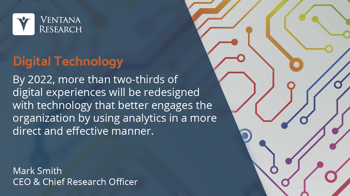
Smart investment requires an effective assessment of an array of technology designed for analytics and data. A solid evaluation includes the following questions:
- Do your technologies support the assembly and personalization of digital experiences from analytics and data across channels and systems?
- Do you have the analytics processes to optimize experiences and increase engagement?
- Do you effectively present your analytics with natural language that can be read and searched?
- Can you manage your analytics and data catalog in a way that enables accessibility and easy processing?
- Are you able to have digital communications on analytics among relevant parties in the organization so they can collaborate and act on them?
- Can you monitor and engage your workforce with digital experiences that you can measure to methodically improve outcomes?
- Are you able to collaborate on specific work tasks with analytics to improve the quality of information and effectiveness of the digital experience?
- Are you able to assess analytics satisfaction with a VoA program and use feedback to make improvements?
A “no” answer to any of these questions indicates risk that could directly impact an organization’s potential with analytics. Every organization, no matter the industry, the number of its employees or the size, has an opportunity to significantly improve its digital experience with analytics and data.
It’s critical that an application enable leaders and managers to adequately plan for and respond to short- and long-term needs, from black-swan events to typical business continuity obligations. Organizations are unwise to even consider any investments that aren’t mobile-ready and powered with collaboration methods across the workforce. We assert that by 2022, one-third of organizations will determine that their business applications are not suited to support their business continuity needs due to ineffective 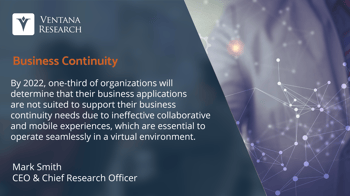 collaborative and mobile experiences, which are essential to operate seamlessly in a virtual environment. Every organization must ensure it has technology that can operate on a mobile device and in a remote location, including from the couch and home office. Organizations should be ruthless about these needs and any technology that impairs the digital experience. While organizations have spent significant resources and efforts on digital transformation in the form of automation and efficiency improvements, a far more important consideration is whether those investments provide the desired impact into analytics and data that empower the entire workforce.
collaborative and mobile experiences, which are essential to operate seamlessly in a virtual environment. Every organization must ensure it has technology that can operate on a mobile device and in a remote location, including from the couch and home office. Organizations should be ruthless about these needs and any technology that impairs the digital experience. While organizations have spent significant resources and efforts on digital transformation in the form of automation and efficiency improvements, a far more important consideration is whether those investments provide the desired impact into analytics and data that empower the entire workforce.
Next Steps
In times of crisis such as the current global health pandemic, when business continuity is a top priority, organizations mustn’t neglect technology investments in the digital experience, especially if this has not previously been a focal point of executive leadership or a team involved with analytics and data-related processes. A superior digital experience demands technology that supports processes that improve productivity, engagement and the overall effectiveness of analytics and data. Leadership that makes smart investments in analytics can have a profound impact on workforce engagement and an organization’s ability to reach expected levels of productivity and performance.
Continuous improvement is a shared responsibility across business and IT leadership, and impossible to do without a strategy that optimizes analytics and data. This approach is not about technology for configuring reports or a dashboard, or just providing a method to search for information using natural language. It’s about a dedicated approach to analytics and data that’s focused on digital experiences — which most organizations continue to lack. Antiquated methods such as one-off extensions to a business application or pretty dashboards not designed for the entire workforce certainly don’t provide a modern digital experience. One-off technology approaches can decrease productivity, diminish accountability and increase risk. It is critical that organizations, especially in times of duress, use business continuity as a driver to improve planning for and the intelligent use of analytics- and data-related communications and processes, and thus should examine their investments in technologies.
If you are not sure how to approach improving the digital aspects of the analytics and data experience — and thus outcomes— through the lens of business continuity, there are specific steps that every organization should take, similar to the steps outlined in my perspective on the imperative for digital innovation in business continuity. The effective use of digital technologies can help an organization reinvent the digital experience — from the outside in and from the inside out. However, accomplishing this requires the right lens that can support business continuity and not distract from it, which can ensure a more comprehensive approach. We assert that by 2022, after a decade of concerted efforts in digital transformation, one-half of organizations will not have established business continuity as an investment priority and will not be prepared to operate in a future pandemic or crisis, which will lead to increased operational risks.
To achieve business continuity, optimize underlying analytics and data processes and technology for your organization’s leadership, management and workforce. This can have an immediate impact on top- and bottom-line results and reflects the priority you place on your digital experience. Once your organization has an effective approach to digitally secure and open communications, along with the right tools for analytics and data, with leadership committed to delivering an optimal digital experience, you can be assured that your organization is built to last. Ensure that existing and future technology investments are designed for effective engagement, not just for automation and efficiency, and is much more than just the digital usage, or the user experience (UX) with analytics and data.
Every digital experience matters, as does the internal team in your organization dedicated to analytics and data across departments fulfilling on the processes that support them. The entire executive team — the CEO’s staff, the CMO, CFO, CIO, CCO, COO, CRO, CHRO and the Chief Digital or Innovation Officers— should be aware of the strategy and plans for optimizing analytics and data processes and supporting digital experiences. Organizational leadership needs to ensure they embrace the discipline it entails throughout the organization. The future depends on the active involvement of those who see building sustainable investments as fundamental to business continuity as they engage the workforce to collaborate and act with purpose.
Determining your path forward for 2020 and beyond requires an effective strategy and an understanding of how to best sustain the required business continuity for your organization. Make sure you are using analytics and data technology that can truly provide an effective digital experience that’s focused on engagement and sustainable long-term results.
Regards,
Mark

Mark Smith
Partner, Head of Software Research
Mark Smith is the Partner, Head of Software Research at ISG, leading the global market agenda as a subject matter expert in digital business and enterprise software. Mark is a digital technology enthusiast using market research and insights to educate and inspire enterprises, software and service providers.









